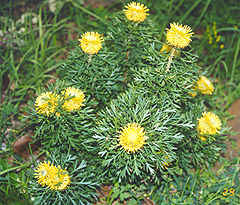
Isopogon anemonifolius
Encyclopedia
Isopogon anemonifolius or Broad-leaved Drumsticks is a shrub that is endemic to eastern New South Wales
in Australia
. In occurs naturally in woodland, open forest and heathland on sandstone soils.
Its height usually ranges between 0.5 and 2 metres, generally being smaller in exposed heathland. The yellow flowers appear during late spring or early summer and are displayed prominently. They are followed by grey cone-like drumsticks, the small hairy seeds found in the old flower parts. The plants leaves are divided and narrow, though broader than the related Isopogon anethifolius
, and have a purplish tinge during the cooler seasons.
such as banksia
s and grevillea
s.
 Woorikee 2000 is a selected dwarf form
Woorikee 2000 is a selected dwarf form
of Isopogon anemonifolius, propagated by Bill Molyneux of Austraflora Nursery in Victoria. It is named for "woorikee", the Australian Aboriginal
word for the Protea
family of plants and the Year 2000.
New South Wales
New South Wales is a state of :Australia, located in the east of the country. It is bordered by Queensland, Victoria and South Australia to the north, south and west respectively. To the east, the state is bordered by the Tasman Sea, which forms part of the Pacific Ocean. New South Wales...
in Australia
Australia
Australia , officially the Commonwealth of Australia, is a country in the Southern Hemisphere comprising the mainland of the Australian continent, the island of Tasmania, and numerous smaller islands in the Indian and Pacific Oceans. It is the world's sixth-largest country by total area...
. In occurs naturally in woodland, open forest and heathland on sandstone soils.
Its height usually ranges between 0.5 and 2 metres, generally being smaller in exposed heathland. The yellow flowers appear during late spring or early summer and are displayed prominently. They are followed by grey cone-like drumsticks, the small hairy seeds found in the old flower parts. The plants leaves are divided and narrow, though broader than the related Isopogon anethifolius
Isopogon anethifolius
Isopogon anethifolius or Narrow-leaved Drumsticks is a bushy shrub that is endemic to coastal areas near Sydney, Australia and in the ranges to the immediate west.It occurs naturally on sandstone in heathland and dry sclerophyll woodland....
, and have a purplish tinge during the cooler seasons.
Cultivation
Isopogon anemonifolius is an easy plant to cultivate in a sandy well-drained soil in a sunny position, though is not as commonly seen as other Australian native plantsFlora of Australia
The flora of Australia comprises a vast assemblage of plant species estimated to over 20,000 vascular and 14,000 non-vascular plants, 250,000 species of fungi and over 3,000 lichens...
such as banksia
Banksia
Banksia is a genus of around 170 species in the plant family Proteaceae. These Australian wildflowers and popular garden plants are easily recognised by their characteristic flower spikes and fruiting "cones" and heads. When it comes to size, banksias range from prostrate woody shrubs to trees up...
s and grevillea
Grevillea
Grevillea is a diverse genus of about 360 species of evergreen flowering plants in the protea family Proteaceae, native to Australia, New Guinea, New Caledonia, and Sulawesi. It was named in honour of Charles Francis Greville. The species range from prostrate shrubs less than 0.5 m tall to trees...
s.
Woorikee 2000

Dwarfing
Dwarfing is a characteristic in plants and animals whereby one or more members of a breed or cultivar are significantly smaller than standard members of their species...
of Isopogon anemonifolius, propagated by Bill Molyneux of Austraflora Nursery in Victoria. It is named for "woorikee", the Australian Aboriginal
Indigenous Australians
Indigenous Australians are the original inhabitants of the Australian continent and nearby islands. The Aboriginal Indigenous Australians migrated from the Indian continent around 75,000 to 100,000 years ago....
word for the Protea
Proteaceae
Proteaceae is a family of flowering plants distributed in the Southern Hemisphere. The family comprises about 80 genera with about 1600 species. Together with the Platanaceae and Nelumbonaceae they make up the order Proteales. Well known genera include Protea, Banksia, Embothrium, Grevillea,...
family of plants and the Year 2000.

